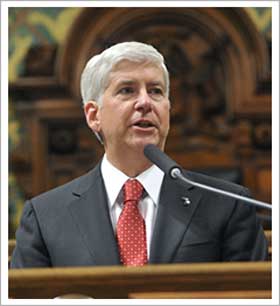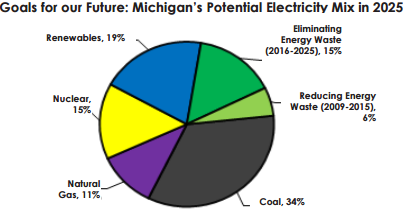By Chris O’Malley
A week after a Michigan lawmaker introduced a bill that would end electric deregulation, fellow Republican and Gov. Rick Snyder unveiled an energy plan of his own that would continue the state’s limited customer choice.
Michigan’s current plan allows up to 10% of an electric utility’s retail load to purchase power from alternative suppliers. Last year, 13 alternative suppliers provided 2,354 MW statewide.
DTE Energy and Consumers Energy have complained that the choice plan makes capacity planning difficult, especially as they retire coal-fired plants and try to gauge how much replacement they’ll need.
On March 5, state Rep. Aric Nesbitt, chairman of the House Committee on Energy Policy, introduced a package of bills that included elimination of electric choice.
“Retail customers currently purchasing electric generation service from an alternative electric supplier must return to receiving electric service from the incumbent electric utility when the primary term of their existing agreement with the alternative electric supplier expires,” reads Nesbitt’s House Bill 4298.
On Friday, Snyder proposed a plan that would retain the 10% customer choice cap and increase the state’s renewable energy goal to 19% by 2025, up from the current 9%. The governor’s plan also calls for reducing energy waste to meet another 21% of Michigan’s energy needs, up from 6%.
Capacity Concerns
Snyder would require that alternative electricity suppliers submit plans to the state Public Service Commission on a rolling, five-year basis that demonstrate that they have adequate capacity and reliability.
“If you want to play, you have to carry your weight as far as being an alternative provider,” Snyder said, speaking at the Detroit Electric Industry Training Center in Warren.
A lack of adequate capacity has been a concern for Michigan regulators as well as MISO. The RTO forecasts that its Zone 7, which includes most of Michigan’s Lower Peninsula, will be 3,000 MW short of its reserve margin in 2016.
Michigan’s commission said that “there appears to be a gap in the planning and procurement of adequate resources for the long-term for customers served under the customer choice program.”
That’s the result of “ambiguity” in responsibility among Michigan’s utilities and alternative suppliers for providing long-term planning reserves and associated cost allocation issues, the commission said.
Utilities say these are trying times for fleet planning, due to the Environmental Protection Agency’s Mercury and Air Toxics Standards (MATS), which take effect this year, and its proposed carbon emission rule.
“We’re expecting the retirements of about 60% of the state’s coal-fired plants in the next 10 to 15 years,” DTE spokesman Scott Simons said. “With the shortfall, we’re planning capacity without that 10%” of customers who buy power from alternative suppliers.
Consumers Energy said it supports Nesbitt’s proposal to return to a fully regulated environment.
“The evidence and historical record is clear that customers benefit the most from the fairness, stability, affordability and investment provided by full state regulation,” the company said in a statement.
Less Choice, Higher Prices
Energy Choice Now, a group pushing for additional deregulation, expressed its appreciation for Snyder’s stance but would have liked the governor to expand customer choice further. “Since 2008, Michigan lawmakers have imposed a system of winners and losers in this state, with 90% of us being the losers,” Executive Director Wayne Kuipers said in a statement shortly after Snyder rolled out his proposal.
Michigan once had “a very successful electricity choice program,” Theodore Bolema, senior policy editor at the Mercatus Center at George Mason University, wrote in a report two years ago for the Michigan-based Mackinac Center for Public Policy.
According to the report, before competition began in the state, in 2002, Michigan’s rates were well above the national and Great Lakes state average. Two years after competition was introduced, rates fell below the national average. But after the 10% cap and other changes in 2008, rates increased rapidly. By the end of 2012, rates were 18% above the national average.
Michigan electric customers have paid $10.5 billion above market rates since 2009, claims Energy Choice Now.
Kuipers noted that there’s a backlog of electric customers who want to join the choice program but cannot because of the 10% cap.
Almost 6,500 customers participated in the electric choice program as of last December, with about 11,000 customers waiting in the queue, according to the PSC.
That doesn’t count other customers who are interested in joining the program but haven’t applied because of the waiting line, Energy Choice Now spokeswoman Maureen McNulty Saxton said.
The choice program is dominated by commercial and industrial customers and public institutions such as school districts. There are virtually no residential customers participating.
MISO Flexible
All MISO states excluding Michigan and Illinois operate under traditional regulated monopolies.
“MISO’s view is that we can work with either regulatory framework,” MISO spokesman Andy Schonert said. “Through the stakeholder process we try to develop an approach that accounts for differences on a state-by-state basis. The resource adequacy requirement and OMS Survey are ways to help give that region-wide view for the regulators and load-serving entities responsible for ensuring resource adequacy.”



